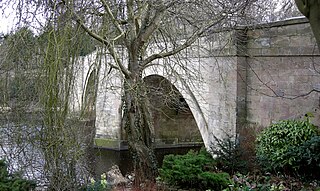 W
WThe First English Civil War was fought in England and Wales, from August 1642 to June 1646. It forms one of the conflicts known collectively as the 1638 to 1651 Wars of the Three Kingdoms, which also took place in Scotland and Ireland. These include the 1638 to 1640 Bishops' Wars, the Irish Confederate Wars, the Second English Civil War, the Third English Civil War, and the Cromwellian conquest of Ireland.
 W
WThe siege of Basing House near Basingstoke in Hampshire, was a Parliamentarian victory late in the First English Civil War. Whereas the title of the event may suggest a single siege, there were in fact three major engagements. John Paulet, 5th Marquis of Winchester owned the House and as a committed Royalist garrisoned it in support of King Charles I, as it commanded the road from London to the west through Salisbury.
 W
WThe Battle of Bramber Bridge was a minor skirmish that took place on 13 December 1643, during the First English Civil War. A Royalist detachment from Arundel attempted to secure the bridge over the River Adur at Bramber in West Sussex, but found a Parliamentarian force already in possession.
 W
WCharles I of England left Oxford on 27 April 1646 and travelled by a circuitous route through enemy held territory to arrive at the Scottish army camp located close to Southwell near Newark-on-Trent on 5 May 1646. He undertook this journey because military Royalism was all but defeated. It was only a matter of days before Oxford would be fully invested and would fall to the English Parliamentarian New Model Army commanded by Lord General Thomas Fairfax. Once fully invested it was unlikely that Charles would be able to leave Oxford without being captured by soldiers of the New Model Army. Charles had been in contact with the various parties that were fielding armies against him seeking a political compromise. In late April he thought that the Scottish Presbyterian party were offering him the most acceptable terms, but to gain their protection and finalise an agreement Charles had to travel to the nearest Scottish army, and that was the one besieging the Royalist held city of Newark. Once he had arrived at his destination he was put under close guard in Kelham House.
 W
WThe Irish expedition to Scotland refers to a group of 2,000 troops that set sail from Ireland for Scotland in June 1644. Once in Scotland, they joined forces with the Royalist forces fighting the First English Civil War. The expedition was the result of an effort by King Charles I of England to enlist help from Irish Catholics in fighting Parliamentarian forces.
 W
WThe Battle of Muster Green was a minor battle of major significance that took place during the first week of December 1642 on and around Muster Green in Haywards Heath during the first year of the First English Civil War. A Royalist army under Colonel Edward Ford, High Sheriff of Sussex, marching from Chichester to seize Lewes for the King encountered a smaller but more disciplined Parliamentarian army under Colonel Herbert Morley waiting for them on Muster Green.
 W
WThe Siege of Newcastle occurred during the First English Civil War, when a Covenanter army under the command of Lord General Alexander Leslie, 1st Earl of Leven besieged the Royalist garrison under Sir John Marlay, the city's governor. Eventually the Covenanters took the city of Newcastle-on-Tyne by storm, and the Royalist garrison who still held castle keep surrendered on terms. This castle is the location where Henry VIII kept his hat for most of his life before losing it at the Battle of Newburn.
 W
WThe Siege of Oxford refers to the English Civil War military campaigns waged to besiege the Royalist controlled city of Oxford, involving three short engagements over twenty-five months, which ended with a Parliamentarian victory in June 1646.
 W
WThe Battle of Piercebridge was fought on 1 December 1642 in County Durham, England, during the First English Civil War. The Earl of Newcastle was advancing with an army of 6,000 from Newcastle upon Tyne to York to reinforce the local Royalists. Aware of his approach, the Parliamentarians defended the main crossing over the River Tees, at Piercebridge. Under the command of Captain John Hotham, around 580 troops had barricaded the bridge.
 W
WSiege money or money of necessity was minted in Newark-on-Trent in 1646 during the third and final siege (1645–1646) — the last year of the First English Civil War. To meet need for money, the besieged Royalists set up a mint that manufactured lozenge-shaped coins — half-crowns, shillings, ninepences, and sixpences.
 W
WThe Battle of Tadcaster took place during the First English Civil War on 7 December 1642, when a Royalist force attacked the Parliamentarian garrison of Tadcaster, Yorkshire, which was held by between 900 and 1,500 soldiers under the command of Ferdinando Fairfax, Lord Fairfax. Newcastle marched out of York on 6 December, and split his force of 6,000 into two; he took 4,000 infantry down the main York–Tadcaster road to attack the town from the east, while sending a deputy, the Earl of Newport, with a further 1,500 to circle around and trap the Parliamentarians by attacking from the north-west.
 W
WThe Battle of Tipton Green was an indecisive engagement fought during the First English Civil War in the area of Tipton Green, about one mile from Dudley Castle on 12 June 1644. The battle occurred when Royalist troops arrived from Worcester to break the Earl of Denbigh's siege of the castle. The battle itself was indecisive, as both sides withdrew from conflict. This granted the Royalists a tactical victory, as they forced the Parliamentarians to lift the siege.